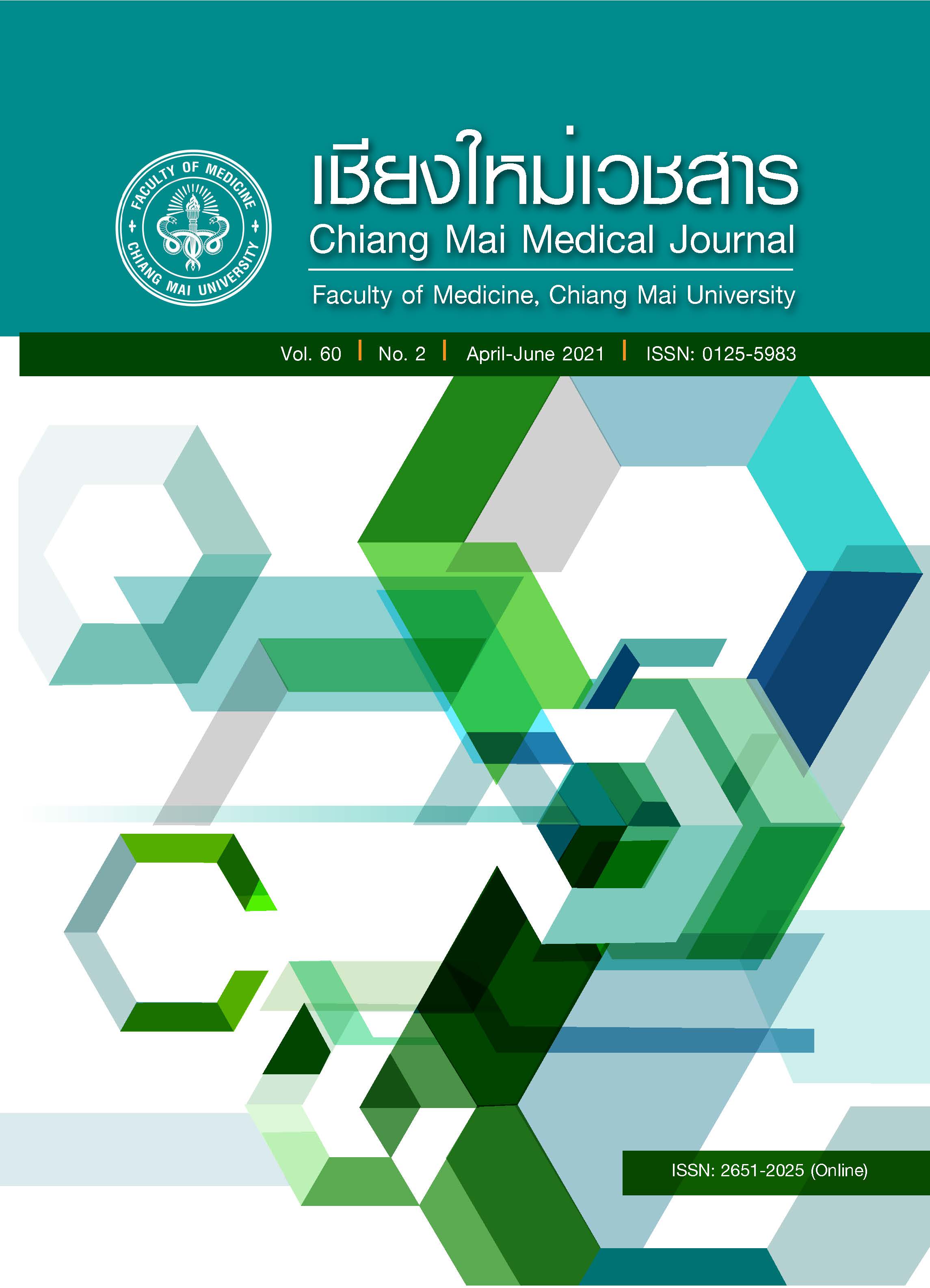การสังเคราะห์งานวิจัยเชิงทดลองและกึ่งทดลองเกี่ยวกับการพยาบาลแบบประคับประคองในประเทศไทย
Main Article Content
บทคัดย่อ
บทคัดย่อ
วัตถุประสงค์ เพื่อศึกษาและวิเคราะห์องค์ความรู้ในการพัฒนาแนวปฏิบัติทางการพยาบาลสำหรับผู้ป่วยทุกกลุ่มโรคที่ได้รับการดูแลแบบประคับประคองในบริบทของประเทศไทย
วิธีการ การสังเคราะห์งานวิจัยเชิงทดลองและกึ่งทดลอง กลุ่มตัวอย่าง คือ วิทยานิพนธ์และรายงานการวิจัยเกี่ยวกับรูปแบบการพยาบาลผู้ป่วยที่ได้รับการดูแลแบบประคับประคองในประเทศไทยที่ได้รับการตีพิมพ์เผยแพร่ระหว่างปี ค.ศ. 2010 – 2020 เครื่องมือที่ใช้ในการเก็บรวบรวมข้อมูล คือ แบบสรุปคุณลักษณะงานวิจัยที่ผู้วิจัยสร้างขึ้น วิเคราะห์ข้อมูลโดยการวิเคราะห์ความถี่และร้อยละ
ผลการศึกษา ผลการสังเคราะห์พบงานวิจัยที่มีความน่าเชื่อถือของหลักฐานเชิงประจักษ์จำนวน 7 เรื่อง จัดอยู่ในระดับ 2.B จำนวน 1 เรื่อง และระดับ 2.C จำนวน 6 เรื่อง สามารถจำแนกผลลัพธ์ของโปรแกรมทางการพยาบาลเป็นการวัดคุณภาพชีวิต ร้อยละ 28.5 (2 เรื่อง) การจัดการกับกลุ่มอาการในผู้ป่วยมะเร็งระยะลุกลาม ร้อยละ 14.3 (1 เรื่อง) การวัดพฤติกรรมการดูแลแบบประคับประคอง ร้อยละ 14.3 (1 เรื่อง) การวัดการปรับตัว ร้อยละ 14.3 (1 เรื่อง) การวัดคุณภาพของการพยาบาล ร้อยละ 14.3 (1 เรื่อง) และการรับรู้ความทุกข์ทรมานจากอาการและคุณภาพของการดูแล (1 เรื่อง) และพบรูปแบบการดูแลผู้ป่วยในระยะของการดูแลแบบประคับประคองและครอบครัว 4 รูปแบบ ได้แก่ การให้ข้อมูลและคำแนะนำอย่างมีแบบแผน การกำหนดรูปแบบการดูแลอย่างเป็นรูปธรรม การสอนและให้คำปรึกษา และการให้ครอบครัวเข้ามามีส่วนร่วมในการดูแลผู้ป่วย
สรุป ผลการศึกษาในครั้งนี้สามารถนำไปใช้เป็นหลักฐานเชิงประจักษ์เพื่อการพัฒนาแนวทางปฏิบัติการดูแลผู้ป่วยแบบประคับประคองที่เหมาะสมกับสภาพปัญหา อาการ และความต้องการของผู้ป่วยต่อไป
Article Details

อนุญาตภายใต้เงื่อนไข Creative Commons Attribution-NonCommercial-NoDerivatives 4.0 International License.
เอกสารอ้างอิง
Panuraj S. The factors related to nurses’ caring behaviors in providing care for end-of-life patient. Pathum Thani: Thammasat University; 2018.
Al-Mahrezi A, Al-Mandhari Z. Palliative care: time for action. Oman Med J. 2016;31:161-3.
Van Mechelen W, Aertgeerts B, De Ceulaer K, Thoonsen B, Vermandere M, Warmenhoven F, et al. Defining the palliative care patient: A systematic review. Palliat Med. 2013;27:197-208.
Nuekwe P, Hanprasitkam K, Junda T. Nurses’ perceptions and practice on palliative care. Thai J Cardio-Thoracic Nurs. 2016;27:128-41.
Singdong P, Jitpunya C. Nursing therapeutics for families of critically illpatients in Intensive Care Unit: a systematic review. Thai J Cardio-Thoracic Nurs. 2011;22:43-57.
Visser C, Hadley G, Wee B. Reality of evidence-based practice in palliative care. Cancer Biol Med. 2015;12:193-200.
Munn Z, Moola S, Lisy K, Riitano D. The Joanna Briggs institute reviewers’ manual 2014. The systematic review of prevalence and incidence data Adelaide: Stamford, Conn: The Joanna Briggs Institute. 2014.
Sotiluk. U, Wisesrith W. Effects of case management combined with palliative care model in patients with metastatic cancer on length of stay and quality of nursing care. The Journal of the Royal Thai Army Nurses. 2017;18:68-75. (in Thai)
Artsanthia J, Tillaput J. The effect of Pallia-tive care to quality of life of people who living with end stage renal disease in community. The Journal of the Royal Thai Army Nurses. 2019;20:226-35. (in Thai)
Jodjum C, Pongthavornkamol K, Na-Ayuthaya SK. The effect of psycho-education program on quality of life in women with cervical cancer undergoing radiation therapy. J Nurs Sci. 2016; 34:143-55.
Molek R, Binhosen V, Pakdevong N-o Symptom intensity in persons with advanced cancer receiving palliative nursing care protocol and caregivers’ satisfaction. Journal of Nursing and Health Care. 2015;33: 102-9. (in Thai)
Morrakot P, Nilmanat K, Matchim Y. Impacts of an Adaptation-promoting programme on the caregiving relatives of terminal chronic disease patients. Thai Journal of Nursing Council. 2015;30:33-45. (in Thai)
Nilmanat K, Sae-chit K. Effects of a case-based management nursing programme for terminally ill patients on their perception of symptom-induced suffering and terminal care quality. Thai Journal of Nursing Council. 2018;33:51-66. (in Thai)
Sanjune S, Yunak R, Tangkawanich T. The effect of village health volunteers’s potentiality development program to provide patients palliative. Journal of Nursing and Health Sciences. 2015;9:68-77. (in Thai)
Stuifbergen AK, Seraphine A, Harrison T, Adachi E. An explanatory model of health promotion and quality of life for persons with post-polio syndrome. Soc Sci Med. 2005;60: 383-93.
Ferrans C, Powers M. Quality of life index: development and psychometric properties. Adv Nurs Sci. 1998;8:15-24.
Chasen M, Bhargava R, Dalzell C, Pereira JL. Attitudes of oncologists towards palliative care and the Edmonton Symptom Assessment System (ESAS) at an Ontario cancer center in Canada. Support Care Cancer. 2015; 23:769-78.
Department of Health Western Australia. Palliative Cre Model of Care. Western Australia, Perth: WA Cancer & Palliative Care Netwok, Department of Health; 2008.
Powell SK, Tahan HM. Case management: a practical guide for education and practice. Philadelphie, Penn: Wolters Kluwer Health; 2018.
Roy C, Andrews HA. The Roy Adaptation Model. Stamford, Conn: Appleton & Lange; 1999.
Nantachaipan P. Case management in the care for patients at the end of life. Nursing Journal. 2015;42:153-8.
Chu C, White N, Stone P. Prognostication in palliative care. Clin Med (Lond). 2019;19:306-10.
Malivan A, Sripunyavuttsuk Y, Attakamon S. Effectiveness of information management program on anxiety and satisfaction for family members at patients in intensive care unit. Journal of Nursing and Education. 2014;7:65-108. (in Thai)
Gardiner C, Harrison M, Ryan T, Jones A. Provision of palliative and end-of-life care in stroke units: a qualitative study. Palliat Med. 2013;27:855-60.
Thongcharoen V, Viripiromgool S, Praditsuwan R, Peachpansri S, Sukkapathanasrikul S. Palliative and end of life care model for older adults. Journal of Public Health and Development. 2017;15:38-59. (in Thai)
Payne S, Burton C, Addington-Hall J, Jones A. End-of-life issues in acute stroke care: a qualitative study of the experiences and preferences of patients and families. Palliat Med. 2010;24:146-53.
Cowey E, Smith LN, Stott DJ, McAlpine CH, Mead GE, Barber M, et al. Impact of a clinical pathway on end-of-life care following stroke: a mixed methods study. Palliat Med. 2015;29:249-59.
Chaleoykitti S, Keskomon T. Health counseling: development of quality of care. Journal of the Police Nurse. 2015;7:253-65. (in Thai)
Arblaster G, Brooks D, Hudson R, Petty M. Terminally ill patients’ expectations of nurses. Aust J Adv Nurs. 1990;7:34-43.
Phengjard J. Nurse’s role in palliative care. Journal of Boromarajonani College of Nursing. 2014;30:100-9. (in Thai)


